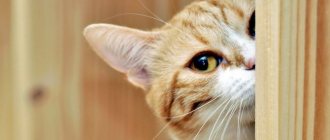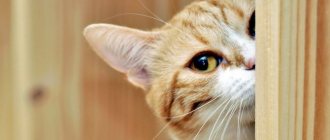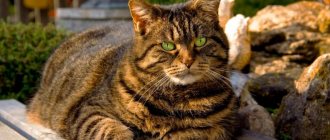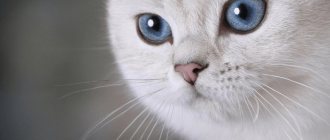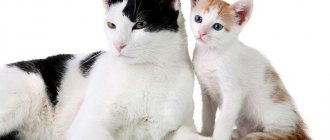Cat to human age ratio
There is no clear linear relationship between cat and human age, so it is difficult to calculate how many human years a cat has.
An approximate conversion of a cat's age to a human age is presented in the table. Table 1 - Comparison of the ages of cats and humans
| Age periods | Cat | Human |
| Childhood | 1 month | 6 months |
| 2 months | 10 months | |
| 3 months | 2 years | |
| 4 months | 5 years | |
| 5 months | 8 years | |
| 6 months | 14 years | |
| 7 months | 15 years | |
| 8 months | 16 years | |
| Youth | 10 months | 17 years |
| 1 year | 18 years | |
| Youth | 2 years | 25 years |
| 3 years | 30 years | |
| 4 years | 35 years | |
| Maturity | 5 years | 40 years |
| 6 years | 43 years | |
| 7 years | 45 years | |
| 8 years | 50 years | |
| 9 years | 55 years | |
| 10 years | 60 years | |
| Elderly age | 11 years | 62 years old |
| 12 years | 65 years old | |
| 13 years | 68 years old | |
| 14 years | 72 years old | |
| 15 years | 74 years old | |
| Senile age | 16 years | 76 years old |
| 17 years | 78 years old | |
| 18 years | 80 years old | |
| 19 years | 90 years old | |
| 20 years | 100 years |
Signs of aging in older cats
A cat enters the senior stage of life at approximately 11 years of age. During this time, your pet may develop chronic diseases such as arthritis and dental disease. These two problems in particular can cause other complications that can affect a cat's lifespan.
A cat usually begins to slow down as he ages. She may lose muscle mass, making it difficult to move around. She may develop arthritis. These conditions mean you should feed your cat less and switch to a senior diet to prevent obesity. This can directly affect her quality of life and longevity.
© shutterstock
Dental disease can lead to another series of equally unpleasant problems. If it hurts your cat to eat, she may stop eating. This, in turn, can cause weight loss and nutritional deficiencies. An inadequate diet also puts your pet at risk of parasites and disease.
Other signs of aging include:
- Hearing loss
- Cataracts and vision loss
- Cancer
- Diabetes
- Kidney disease
The risk of these conditions increases with age. Therefore, regular veterinary care is absolutely essential for your cat's health.
Life stages of cats
In cats, it is customary to distinguish three main stages of life - childhood and adolescence, youth and maturity, old age and old age. During these periods, the animal’s behavior and its relationship with the outside world change.
Childhood and youth
Childhood and adolescence are a period of learning useful skills and learning about the world. During this period, animals are especially active and energetic. By the age of two months, kittens develop normal coordination of movements, they feed independently and know how to use a litter tray. 2-3 months is the optimal age for handing over babies to new owners. Puberty begins at 4-6 months. By the age of one year, cats become fully grown, capable of obtaining food by hunting and bearing offspring. During childhood and adolescence, animals are still inexperienced, but curious, active and fearless, susceptible to infections, so at this stage you should create the safest possible living environment for them.
Youth and maturity
Young cats retain their youthful excess of energy and continue to gain life experience. During this period, the immune system finally matures. From 3-5 years old, animals become calmer, although they are not averse to playing with their owner and spend a lot of time hunting (including inanimate objects). Their regime is measured - food, entertainment and rest on a schedule. Cats are usually more self-sufficient; cats are more attached to their owner. This is the heyday of cat life, procreation.
Elderly and senile age
Elderly cats are calm and complacent; they like to be alone and sleep. These are wise animals that understand the person they love and trust perfectly. They are more conservative and often react to changes in the environment with stress and irritation. During this period, the immune response and the ability to thermoregulate weaken – the pet becomes sensitive to infections and does not tolerate heat and cold well. Elderly animals often react painfully to the arrival of a new pet in the house. At the end of its life, a cat needs to be protected from any changes and stress, and given enough attention.
Does breed affect life expectancy?
Actually the answer to this question is yes. They can live much longer:
- mongrel cats;
- animals of natural or long-bred breeds.
Exotic cat breeds bred by humans live much shorter lives.
The reason lies in the fact that in order to preserve the characteristics of the breed (in the British , Maine Coons , Munchkins, Cornish Rex, exotics ), a small number of individuals are involved in breeding.
Cats that are not bred through selective breeding have much better developed immune systems and survival abilities.
Older cats need to rest more often
How to determine the age of a cat by external signs
It is extremely difficult to determine the age of an adult cat by its appearance. Often animals of very advanced age do not look decrepit and weak. If the age of the new pet is unknown, you can try to find it out using the following parameters:
- Teeth. The only reliable criterion for determining age is the appearance and change of teeth - useful only for kittens. At 2-3 weeks, babies develop incisors, at 3-4 - canines, at 3-6 - premolars. Then, at 3-4 months, the incisors change, and at 4-6 months, the remaining teeth. By 7 months, the change of teeth is completed. After 1-1.5 years, a yellowish coating appears on the surface of the teeth, which becomes more intense over the years. Age-related tooth loss is an individual factor: some 16-year-old cats can boast a fully “complete” toothy mouth, and in some, dental diseases accompanied by tooth loss occur as early as one year of age.
- Wool. Until old age, healthy cats have a smooth and shiny coat and a dense undercoat. Then the undercoat thins out and the coat becomes less smooth. In long-haired animals in old age, a decrease in the volume of the tail due to wool is clearly noticeable. After 8-10 years, individual gray hairs may appear (total graying, as in humans, does not occur in cats). In old people, the fur becomes dull, the mustache thins and shortens.
- To the eyes. Up to 1-2 years, cats will retain “kitten” curiosity and enthusiasm in their eyes, even during rest. Older individuals look at the world more calmly and lazily. After 10-12 years, the eyes begin to gradually “sink”, but their clarity remains until old age, if the pet is healthy.
- Conditions. The body of young cats feels soft and plastic, and after 5 years it becomes denser, as if “hardening” (which does not in any way affect their dexterity). After 8-10 years, the contours of the cheeks, chin and body become less rounded. In old age, the muscular system and fat layer undergo dystrophic changes, the animal loses weight and “shrinks out.”
- Musculoskeletal system. The condition of the musculoskeletal system in cats changes little over the years, so gait practically does not change with age, and the ability to jump high remains in old age. Joint stiffness with a noticeable decrease in physical activity is typical in old age
A veterinarian can more accurately determine the age of a cat by examining the fundus of the eye or by the condition of the internal organs during surgery.
Does an animal's lifestyle matter?
For cats to live happily ever after, they need to be given the most favorable conditions possible. These include:
- proper, balanced nutrition;
- cozy, warm house ;
- no injuries;
- periodic visits to the veterinarian;
- protection from external adverse factors.
If you are interested in detailed information about proper grooming, we recommend that you read the article
In addition, the following factors affect life expectancy in cats:
- heredity;
- presence/absence of genetic diseases.
It is worth noting that sterilized cats and castrated cats have a longer life expectancy than individuals participating in procreation.
We recommend an article on the importance of sterilizing cats
The absence of stress during the mating season has a positive effect on their condition.
Neutered cats live longer
Interesting! According to the observations of veterinarians, the life expectancy in most cases in cats is from 10 to 15 years.
Long-lived cats
Famous cats and cats - record holders for life expectancy:
- Lucy the cat – 39 years old (born in 1972, the record was registered during the cat’s lifetime in 2011), South Wales, UK
- Cat Cream Puff – 38 years old (1967-2005), Texas, USA
- Baby Cat – 37 years old (1970-2007), Minnesota, USA
- Cat Granpa Rex Allen - 34 years old (1964-1998), Texas, USA
- Scooter the Cat – 30 years old (1986-2016), Texas, USA
In the photo, the long-lived cat Cream Puff
There is no relationship between the breed of a cat and its lifespan. Representatives of indigenous breeds (Norwegian Forest, Siberian, Maine Coon) were distinguished by good health and longevity until they were affected by mass artificial breeding.
The importance of determining age
Age becomes an issue before you even bring your pet home. When this happens, one of the first decisions you will make. This can mean the difference between a cat that handles the transition well and a cat that is nervous due to behavior problems. The next step is to have your pet spayed or neutered. This may vary depending on the development of the cat breed.
poroda-koshek.com
Another important decision involves your pet's diet. Kittens and adult cats have different nutritional needs. For example, a younger pet should receive more protein, calcium and other nutrients to support its development. Likewise, older pets have different requirements. All animals, including humans, slow down with age. This means dietary changes.
How to extend the life of a cat
The following factors influence a cat's lifespan:
- Self-walking. Vagrancy should be avoided; in urban conditions, letting a cat out of the house unattended is doubly dangerous. Such walks often end in injury, incurable infection (viral leukemia, immunodeficiency) and death. It is better to fence the dacha area so that the cat cannot leave its boundaries, or equip it with a spacious enclosure.
- Nutrition. The diet should be fresh, balanced, and appropriate to the age of the animal. Industrial feed should be chosen at least premium class. If ready-made food is not suitable for some reason, the cat should be prepared separately; you should not feed it food from the human table.
- Regular vaccination. It is necessary to vaccinate all pets, including those who do not leave the house (the causative agent of the infection can come from the outside, from the owner’s shoes or clothes).
- Control of reproduction. It is best to neuter your pet. In fertile cats, do not give birth more often than once every 1-2 years (at the age of no earlier than 2 years and no later than 6-7).
- Veterinary control. At the first sign of illness, your pet should be seen by a doctor. For older cats, an annual preventive examination is recommended, including a general examination, blood, urine and feces tests, and consultation with a cardiologist.
- Living conditions. The cat should have a resting place in the house, where no one will disturb it, and enough toys for active pastime. The litter tray must be placed in a secluded place and kept clean.
Compliance with the rules of keeping, love, creating a calm and friendly atmosphere in the house is the key to a happy and long life for your pet.
Simple Arithmetic
A very simple way to find out how old a cat lives by human standards is to multiply the animal's age by 7. This method gives the most inaccurate result of all those listed above, for example, a one-year-old cat is more independent than a child aged 7
. The reason is that our pets are driven mainly by instincts, which help them adapt faster. Also, cats more often live to be 20 years old than humans are to live to be 140. This arithmetic method, in which the year of a cat’s life by human standards is equal to 7 years, does not make it possible to compare the stages of development of intelligence.
Converting a cat's age to human age using the proposed systems is not difficult. The main problem is that none of the existing methods will give an accurate result.
Elderly (15-19 years old) and old age (over 19 years old)
If you monitor your cat’s health, then even in old age (15-19 years) he will be quite vigorous, resembling a person from 60 to 75 years old. Of course, the cat’s activity will decrease, his habits and daily cycles will begin to change, and he will require more careful and attentive care.
Read about caring for an elderly pet: Features of caring for old cats
We would be lying if we say that a cat after 17-18 years can be completely healthy. In the end, sooner or later a person inevitably begins to have health problems. But even in these years, the owner and the pet can give each other joy, good care, attention and care can make the last years of the pet easier and delay the inevitable death, ideally closer to 23-25 years. And the record-breaking cat, by the way, lived for 38 years!
What cat breeds live the longest?
Interestingly, research shows that mixed or crossbred cats are more durable than their purebred counterparts. You may ask why is this true?
Perhaps the deciding factor is breeding. If cats are inbred, there is a greater risk that the offspring will inherit an undesirable trait, such as deafness. If both sibling parents have the gene that codes for the disease, the chances of kittens getting a bad copy from both of them are higher. On the other hand, outbred cats that are not related are likely to have healthier babies.
The cat, who is 15 years old, has lived a long life. The fact remains: with proper care and nutrition, some animals can live up to 30 years
Adolescence (6 months – 1 year)
At this time, the kitten is a real teenager by human standards. Continues to grow actively, although it is already beginning to resemble an adult. He has even more energy than before, he needs no less attention, and his character may begin to emerge. Interest in the opposite sex appears. This is the best time to spay or neuter your pet. These procedures are completely safe and will only save your pet from health problems, and you from headaches due to cat cries during hormonal peaks and/or the placement of offspring.
Read more: At what age are cats spayed?
